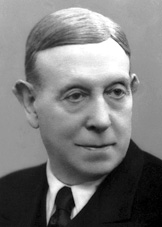Egas Moniz
From Psy3241
Antonio Egas Moniz (1874-1955) was a Portuguese neurologist who refined the lobotomy as a surgical procedure to relieve anxiety, depression and schizophrenia in psychiatric patients. Although there was no empirical evidence supporting his theory, Moniz hypothesized that by severing the connections of the frontal lobe, he could also sever the neural impulses that were responsible for the obsessive, paranoid ideas that characterized his patients� mental illnesses.
His first lobotomy was performed in 1935 on a woman suffering from severe agitation and paranoia. Though later procedures involved severing the frontal lobe with a wire, in his first attempt, Moniz drilled several holes into the patient�s skull and injected alcohol into the openings. According to his reports, the woman�s condition improved, although he admitted that her emotional affect was compromised as a result of the surgery
Despite the extreme subjectivity in his medical publications and the lack of rational justification regarding the psychosurgery, Moniz�s lobotomy procedure was met with high regard by other neurosurgeons. Many speculate that the desperate need for psychiatric treatment at the time may have contributed to this seemingly unwarranted acceptance of lobotomy into the medical community.
Moniz contributed much to neurology in his time ; besides his infamous lobotomy, he also further developed a technique that allowed doctors to see blood vessels in the brain by injecting radioactive tracers. But because he was awarded the Nobel Prize in 1949 (in physiology/medicine) for his psychosurgery, and because of its controversial popularity, this procedure is the contribution that is most attributed to his fame.
Relatives of patients who underwent lobotomies want the nobel prize given to Moniz revoked, despite the fact that he has been dead for over 50 years. These relatives, as well as modern neurologists, contest that the surgical procedure harmed a substantial number of people, was used in inappropriate circumstances (for example, to cure constant headaches, mental retardation, and anxiety), and left the patients severely incapacitated, and emotionally deficient.
Many claim that Moniz�s lobotomy was only a slightly less gruesome version of the procedure developed by U.S. neurosurgeon Walter Freeman, which involved drilling an ice pick above the patient�s eye socket to sever nerve fibers.
The Nobel Foundation claims that Moniz deserved the prize because there were no alternative treatments for psychiatric patients around at the time, and there is no possibility that the award will be revoked.
References:

